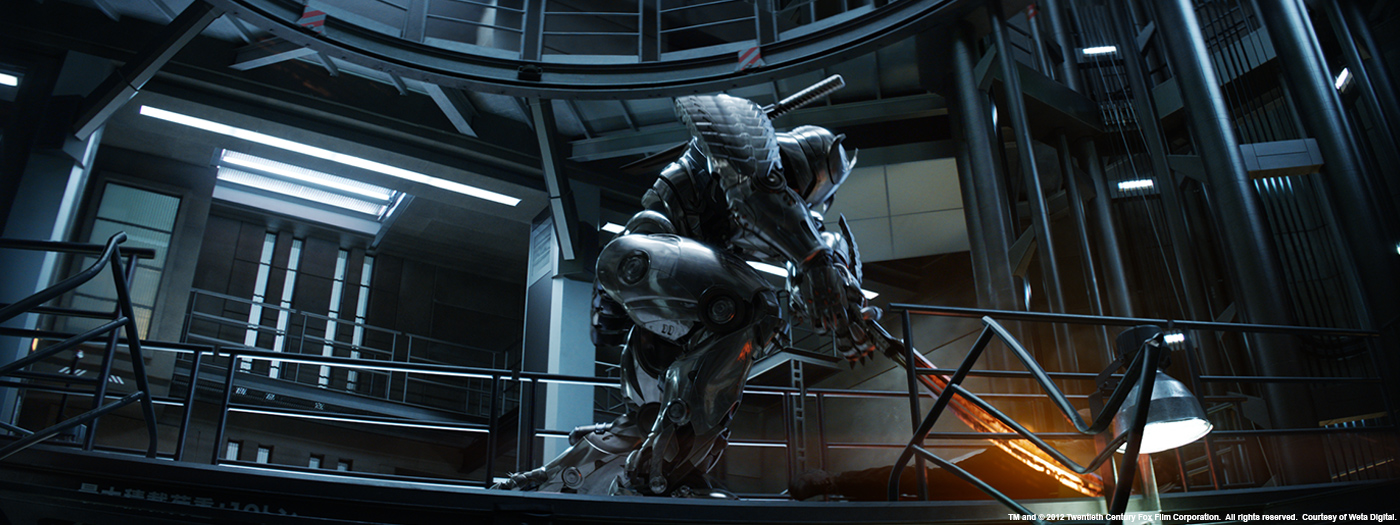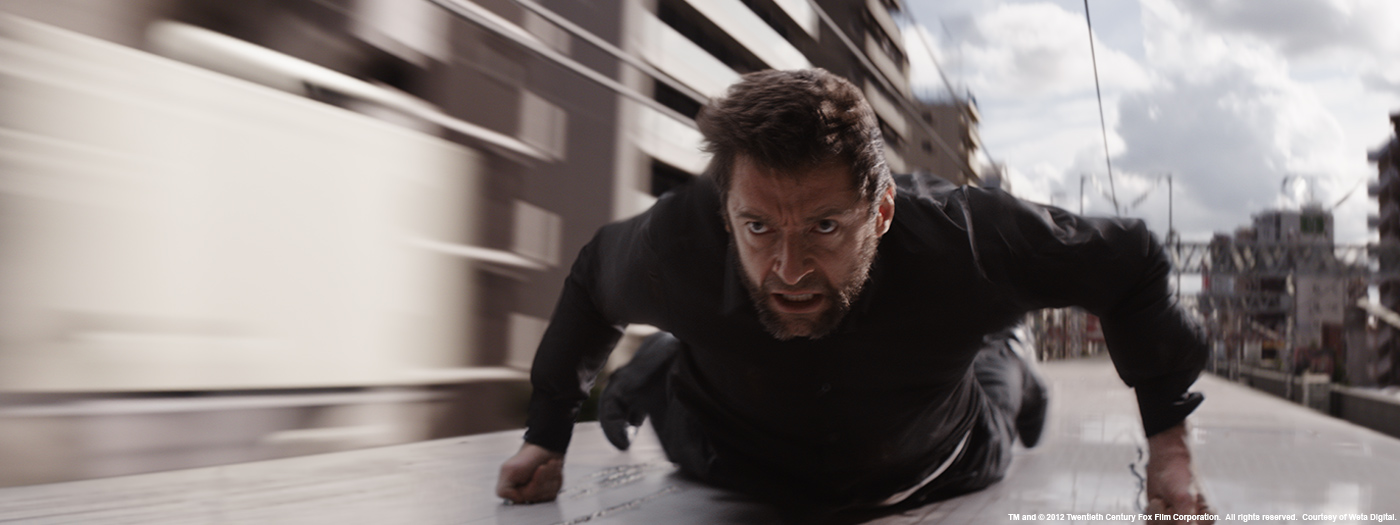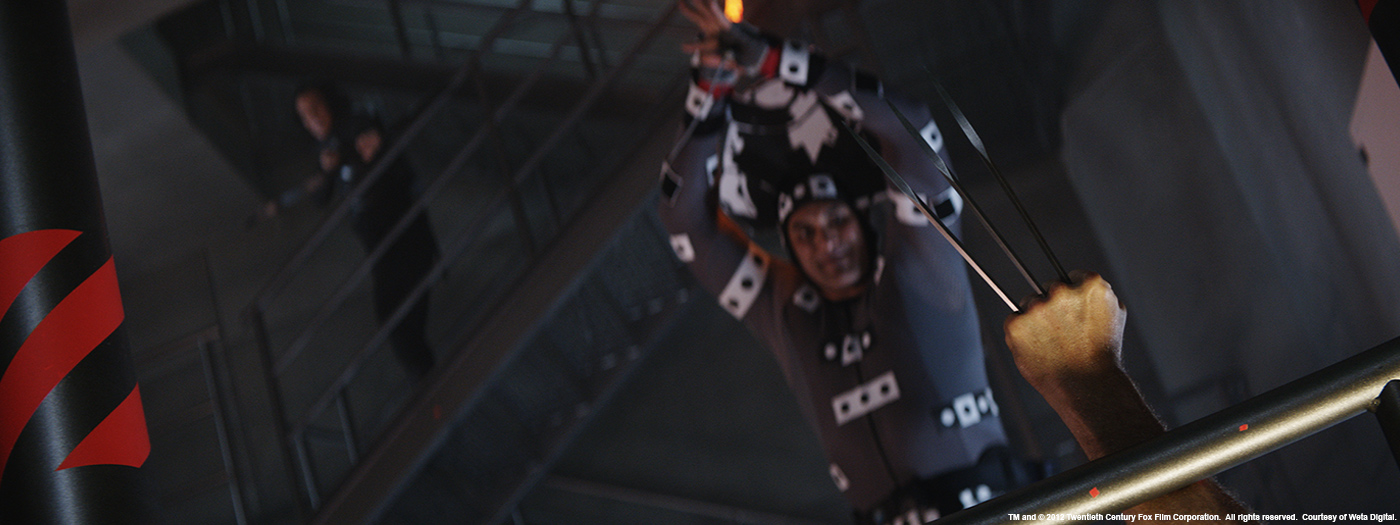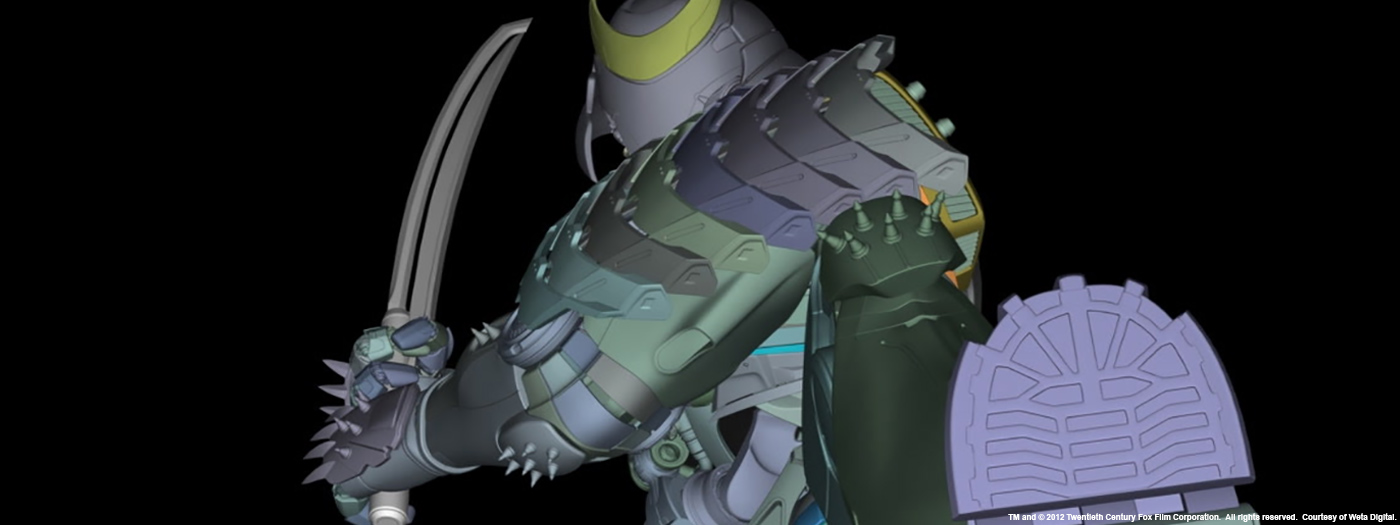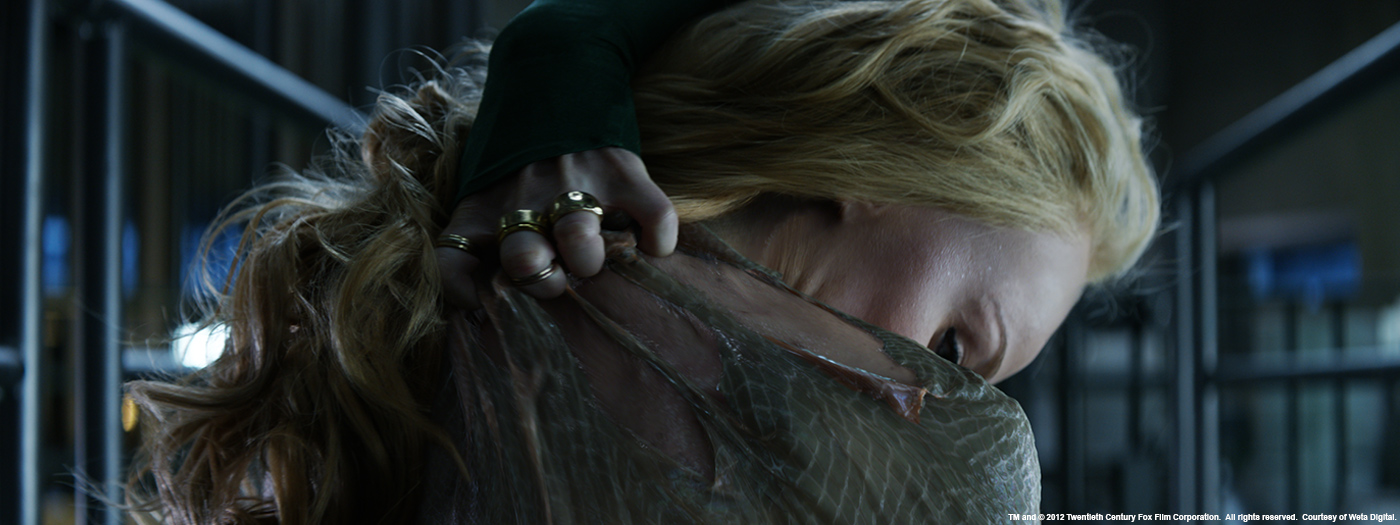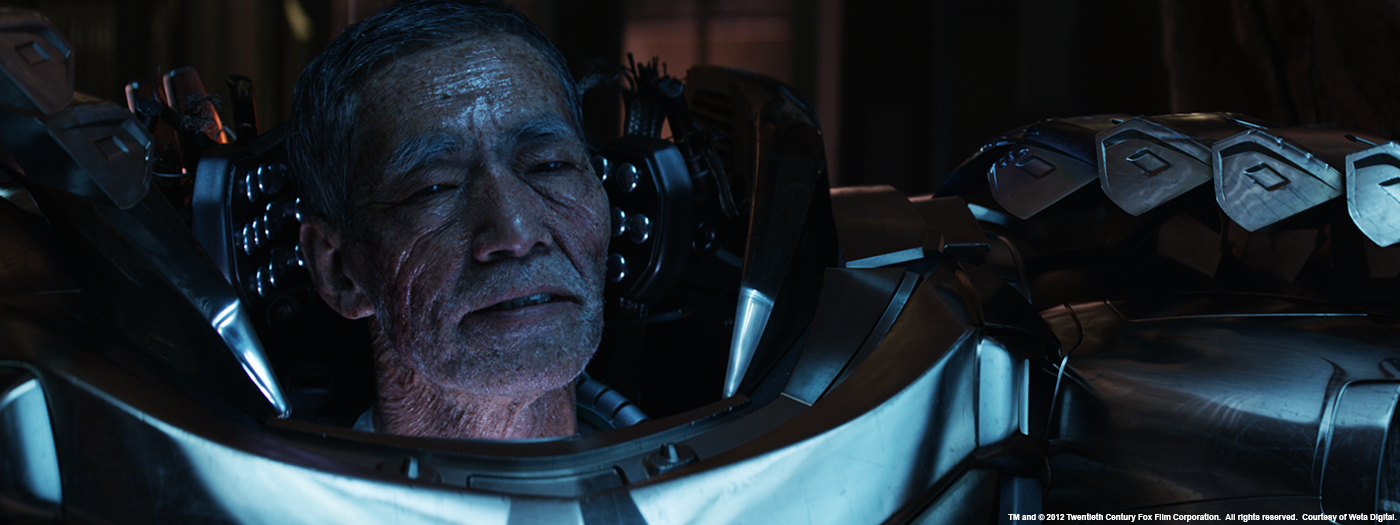In 2012, Martin Hill had explained to us the work of Weta Digital on PROMETHEUS. He then worked on ABRAHAM LINCOLN: VAMPIRE HUNTER and THE HOBBIT: AN UNEXPECTED JOURNEY.
What have you done on this show?
We worked on the bullet train sequence, the Bear, the Silver Samurai and Yashida lab sequence, Viper’s skin peeling effect and the aging and de-aging of Yashida and Logan.
How did you enhance the animatronic bear?
For the night bear sequence the performance of the Bear on set wasn’t giving the emotional range that Jim wanted, so we enhanced and replaced the Bear digitally on most of the shots. The process involved creating a match-moved facial performance of the on-set bear, then creating an animated facial and head performance of the bear to hit the beats that Jim required with regards to timing and the facial expression. We then projected the plate onto the matchmoved geo and warped to the new performance in 3D. Obviously there’s a limit to how far 2 1/2 D techniques can go so for areas that were problematically creasing or revealing too much occluded geo we’d revisit the performance, or add fully digital fur to cover. For all shots we replaced the jaw, mouth interior and teeth, added drool and breath, then replaced the eyes.
Did you create a full CG bear for specific shots?
Yes for all the daytime shots, and a couple of the night ones.
An impressive fight took place on top of a speed train. How did you approach this sequence?
Obviously this couldn’t be shot for real on a train, so we had to create the BG’s, train and all the track furniture in post. Phil Brennan the VFX Supervisor had the great idea of shooting footage on the back of a van on an elevated freeway, Google Street View style, with 8 Red Epics creating a panorama. The footage was shot at 48 fps with the van travelling at 60 kph, we re-sped this between 9x and 14x depending on the shot, so at 24fps we reached speeds between 270 and 420 kph. This formed the basis of our backgrounds and with augmenting with one-point perspective or reprojecting the footage to create buildings, using photogrammetry techniques we could make the footage work with the tracked green screen plates of the actors. We then added the trains, gantries, wires, track furniture and billboards tying the foreground and background together.
Can you tell us more about how this fight was shot?
The green screen elements were shot on 4 separate partial train sets, one for the side of the train where Logan is thrown out, the rest for the fight on the top for various stunt and wire setups. There was a propeller in front of the 10k key light to simulate the gantries overhead.
Can you tell us more about the digi-doubles creation?
Depending on the requirements of the digidouble we build them in different ways. For example the digidoubles for the Bullet Train fight required very detailed cloth layers for the wind simulation flapping at the clothes, however the facial animation could be quite basic, often just a still scan of the actor’s face in pose for the fast and distant shots. For extreme close ups with facial performance and dialogue, for example for the Yashida aging, we used multiple facial scans and a full FACS session where we record the actor performing a full set of phonemes and expressions for multiple positions.
At the end, Logan confronts the Silver Samurai. How did you create this character?
Art department had created a full size version of the Samurai, which wasn’t able to move. Once we were involved with the motion and creating the personality and fighting style, we had to augment the design slightly to accommodate some of the articulation required.
Can you tell us more about the rigging and animation challenges?
Matthew Muntean our Creatures Supervisor and his team did a fantastic job of treading the fine line between keeping the bulk and weight of the design and still allowing the range of movement of the samurai. One of the main issues was the broadness of the chest. Jim wanted very traditional stances to be used with the sword, when the Samurai held the katana in two hands in front of him either the arms collided with the chest or the posing was awkward. We didn’t want to compromise the performance so we reworked the design, and did some per shot tweaks to the chest and arms, folding some pieces away and sculpting away the intersections where the perspective allowed us to get away with it.
What direction did you receive from director James Mangold for the Silver Samurai animation?
Jim was very specific about it being traditional movements, but believable and exciting. Mike Cozens our animation supervisor and his team were constantly balancing the weight of this giant heavily built machine whilst keeping the grace and poise of the martial arts. Often we’d try multiple versions of an action, particularly the jumps and sword work, to get the right amount of acrobatic movement for the character, too much and it looked contrived and light. We referenced a lot of Japanese martial arts and recorded Kendo demonstrations in the office.
How did you handle the metallic aspect of the Samurai?
Our lookdev team, Kris Jasper and Brandon Onstott, did a lot of research going as far as milling swatches of metal to come up with the right brushed chrome look, which was turned into an elaborate but physically plausible model, which responded to light really well. A lot of imperfections were added to help moving away from the digital look, this is ongoing throughout the sequence as he becomes more damaged. The burns from the sword on the metal were modelled on arc welding and the iridescent patterns that are created.
Silver Samurai is using a burning sword. Can you explain more about it?
This was a great example of when Jim gave us some free rein, and asked what we could come up with. We looked at the traditional forging process that a katana goes through with its many layers, and whilst being pounded with hammers layers break off and reveal hotter layers underneath in these amazing patterns and looked very very hot, so we recreated that effect digitally. Joe Churchill did some fantastic shader work using physical black body radiation and Brian Goodwin, our fx lead, created the smoke/steam effect that accompanied it.
How did you create the skin shedding of The Viper?
On set Svetlana mimed the performance, unfortunately there was no object for resistance to her peeling skin action, however Svetlana did a great job putting some weight into it. Before we started any effect, we retimed and warped the plate to add more tension to the performance then worked from that.
You can see the shedding effect at the end of this clip.
The matchmove needed to be incredibly tight. We had quite a high density of markers on Svetlana’s skin, but getting a perfect match under the neck, on the platysma especially was difficult. Once we had that working, we used a combination of 2 ½ D techniques to apply textural and lighting layers onto Viper’s skin. Fantastic work by Evelyne Leblond and Phil Leonhardt.
Can you explain in details about the aging and de-aging of Yoshida?
Similar to Viper we needed incredibly tight matchmoves of the actor on the plate. Using FACS data and scans we created versions of each age of the actor, with the ability to transfer the animated matchmove of the facial and dialogue of the characters onto the other ages of the character. This blend was done in a nonlinear fashion both temporally and spatially and formed the basis of our transition. We created three more blending maps for the displacement, specular and texture, these were created in UV space by comp who used an Alembic file of the geo within Nuke to unwrap the blending maps, then ported back to creatures and lighting. This model was lit and rendered to match the plate for each version, using the original plate actor version as a sanity check for the blending model, making sure we had a believable human.
We definitely didn’t want a morph or a wipe effect, and a great deal of care was put in by the team to keep the progression of the effect subtle, so you couldn’t exactly pin down the changes, though the character deformed hugely during a single shot. CG hair and beard were applied, which disappear and reappear over the sequence. The final result required a lot of fine crafting in Comp to recombine with the plate. We kept but augmented various elements like the eyeballs and the teeth, which helped to keep the original performance of the actors.
Was there a shot or a sequence that prevented you from sleep?
Probably Viper, the ageing effects – Though also the Samurai and Train sequences…. I didn’t get a lot of sleep!
What do you keep from this experience?
Fantastic crew at Weta to work with, special thanks to Annette Wullems, my producer. Really great, creative and knowledgeable clients made this a really fun show to work on.
Many shots of the Bullet Train and the Silver Samurai are in this clip.
How long have you worked on this film?
Started breakdowns around September whilst still on THE HOBBIT, finished May, around 8 months in total.
How many shots have you done?
370.
What was the size of your team?
It varied throughout the project depending on the other shows that were running concurrently.
What is your next project?
I’m not sure yet, currently on vacation!
A big thanks for your time.
// WANT TO KNOW MORE?
– Weta Digital: Official website of Weta Digital.
© Vincent Frei – The Art of VFX – 2013


